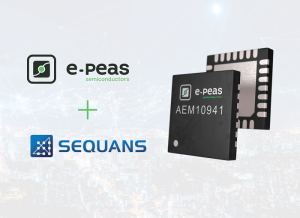Energy harvesting technology is expected to transform the IoT market, enabling devices to operate without batteries. Companies like Sequans Communications S.A., a maker of 5G/4G chips and modules, and e-peas, a supplier of advanced energy harvesting solutions, expect energy harvesting to increase the number and types of applications that can be connected to the IoT, while also providing more sustainable IoT solutions. The two companies have demonstrated a joint energy harvesting cellular IoT connectivity solution that can operate indefinitely without batteries.

(Image: e-peas)
The solution leverages e-peas’ AEM energy harvesting IC with Sequans’ Monarch LTE-M/NB-IoT platform to provide a self-powered cellular IoT connectivity solution in a small package. The demo shows the e-peas AEM10941 IC transferring energy from a photovoltaic harvester to a storage element and then to Sequans’ Monarch LTE-M/NB-IoT module where it powers a sensor device measuring power, light, and humidity.
The demo kit is supplied with a small indoor DSC photovoltaic cell that can power a variety of IoT applications using indoor light and LTE connectivity. In an outdoor environment, the size of the photovoltaic cell can be reduced to allow for energy-autonomous devices in an even smaller form factor, said the companies.
In a typical application, the companies noted that the combination of the e-peas AEM10941 IC and Sequans’ Monarch module enables the collected data from the device sensors to be sent up to eight times a day, without requiring batteries, using a 15 cm2 indoor photovoltaic cell under 500 Lux.
The solution shows how IoT companies can provide non-stop, zero-maintenance operation of IoT devices through energy harvesting, according to e-peas. Sequans and e-peas are offering a reference design with schematics for IoT companies.
Advertisement
Learn more about Sequans Communications





